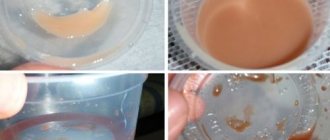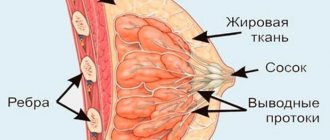The main function of the breast is to produce milk for subsequent feeding of the offspring. The mammary glands undergo the greatest changes during pregnancy and lactation.
Normally, milky or transparent droplets may appear from the nipple in the following cases: after conception, the entire gestation period (from 20-22 weeks, sometimes earlier); after termination of pregnancy, even in the early stages; during lactation; after the end of breastfeeding, slight discharge from the nipples can be observed for another two years.
In a non-pregnant state, women are also allowed small discharge from the mammary glands: with regular stimulation of the nipples; a few days before menstruation; during sex.
The release of colostrum not associated with pregnancy and childbirth is called galactorrhea. May be due to the following diseases:
- Pituitary microadenoma . The tumor is only a few millimeters in size. It is detected in most cases during a random examination, as well as when searching for the causes of infertility and galactorrhea. With it, the intensity of discharge can range from a few drops to a stream of secretion.
- Functional hyperprolactinemia occurs from inflammatory processes in the genital organs; taking medications (antidepressants, for example, amitriptyline and others, affecting the functioning of the brain, lead to an increase in prolactin levels while taking the drug); hypothyroidism – decreased function of the thyroid gland.
- Mastopathy as a consequence of hormonal. The fibrocystic form is often found, and women do not detect formations upon palpation, but when pressed, droplets of liquid, transparent, whitish, yellowish or slightly greenish, are released.
Fibrocystic mastopathy
- Expansion of lobular ducts. It is more common in premenopausal women. Its essence lies in ectasia (expansion) of the ducts, which were previously necessary for the movement of milk. Secretions can stagnate in them, and sometimes they can become inflamed.
- Papillomatous growths . They arise inside the milky passages. More often, papillomas form in areas of the ducts located close to the areola. They are easily injured even with the slightest pressure on this area. As a result, the girl notes the appearance of bloody discharge of varying intensity; no pain or any previous symptoms.
- Acute or chronic inflammatory process in the mammary glands . Mastitis is more common during breastfeeding. But it is also possible outside of lactation. Usually in this case, the woman notes the presence of chronic sources of infection in the breast - fungal or bacterial in nature.
- Chest injuries . Emptying a hematoma is brown or bloody discharge from the chest. When inflammation occurs, they can become purulent, with an unpleasant odor, and the condition is accompanied by pain and fever.
- Malignant tumors . In the initial stages, they often occur without symptoms; you can only detect a small compaction in its superficial location. Discharge may appear due to Paget's disease (a form of cancer).
It is worth seeing a doctor and undergoing examinations: a blood test for tumor marker - CA-15.3, ultrasound of the mammary glands, mammography, ductography.
Read more in our article about the reasons for the appearance of colostrum before menstruation.
Dispelling popular myths about colostrum
There are many different statements about colostrum, most of them are far from reality.
Main myths:
- The release of colostrum indicates the approach of labor - there is no relationship between these processes; immature milk may appear immediately after conception, or not appear at all.
- The amount of colostrum is related to the amount of breast milk - the volume of unripe milk does not affect the quality, fat content and quantity of milk.
- If colostrum suddenly disappears, there will be no milk. During pregnancy, unripe milk appears and disappears; this is a normal process. After childbirth, everything will definitely appear, both colostrum and milk.
The release of colostrum is a very individual process, like every pregnancy, so don’t be nervous if something doesn’t go as it does for others. If something worries you, you can always consult your gynecologist.
Galactorrhea
Galactorrhea is the release of colostrum after the lactation period. The woman has already stopped feeding her baby milk, but white liquid continues to appear from the breast even after 3-5 months after the end of feeding. In such a situation, you should definitely visit a doctor.
The causes of prolonged galactorrhea may be the following:
- disorders of the thyroid gland;
- ovarian dysfunction;
- adverse reactions to taking oral contraceptives or other drugs;
- use of decoctions of certain herbs;
- improperly selected tight bra;
- breast growths or injury;
- renal or liver failure.
Normal galactorrhea, unlike pathological one, is distinguished by its “correct” duration. It lasts up to six months after stopping breastfeeding. And then the emerging symptom of galactorrhea in the form of colostrum may indicate problems.
What is considered normal
It is normal for colostrum to be released a week before your period during conception. Also, after completing breastfeeding, it is possible to observe periodic or constant appearance of secretions for 2 years.
There are several other cases in which the appearance of colostrum is considered normal:
- Strong sexual arousal. It provokes a large amount of blood flow, which stimulates the work of the alveoli, which are responsible for milk production.
- Nipple stimulation. It also stimulates libido and the filling of the mammary glands with blood. A signal is sent to the brain about the development of sucking processes and the need to secrete milk to feed the baby. But since during the period when a woman has not given birth, a rather small amount of the hormone prolactin is released, it is only enough for a couple of drops of colostrum. However, there are cases where a nulliparous woman, with constant breastfeeding of her baby, began full lactation.
- Thermal effects on the chest. It also stimulates blood flow to the breast tissue. This can happen after a sauna, steam bath, heavy physical activity, sunbathing, etc.
Mastitis
This acute disease of the mammary gland is infectious in nature. Most often it occurs during breastfeeding. The mammary gland swells and becomes very painful when touched, as a rule, body temperature rises to 39 degrees. A greenish liquid with purulent impurities is released from the chest.
Mastitis can occur due to poor personal hygiene, infection caused by infection in cracks in the nipple, or improper expression of milk. In such a case, you should under no circumstances delay contacting a doctor.
Types of breast discharge
The color and consistency of the liquid will help the specialist figure out the reason for its appearance. Characteristic symptoms:
- Colorless, transparent, odorless. Discharge from the nipples before menstruation does not entail pathological changes.
- White. They can occur in the postpartum period - when milk appears, as well as in the case of the formation of a brain tumor. Long-term use of contraceptive medications can also cause fluid to appear.
- Green. When mastitis appears, due to the formation of pus.
- The yellow color of the discharge with a predominance of cream-colored patches appears during pregnancy and in the first days after childbirth. The release of colostrum before menstruation may indicate a pathological condition of a woman’s mammary glands.
- Brown. Appear when small vessels are damaged and enter the blood ducts. They occur when cysts appear, as well as benign and malignant neoplasms of the mammary glands.
- Bloody. Occurs as a result of the growth of cancer cells. The color can be light or dark.
Pregnancy
The ducts of healthy mammary glands in their normal state are no larger than peas in size. When pregnancy occurs, they can increase several times. This phenomenon can even frighten inexperienced young women. Due to changes in the breasts under the influence of hormones, the expectant mother will notice the appearance of white or yellowish discharge from the nipples within a month.
Very often, pregnant women can discuss the timing of the appearance of colostrum among themselves, but this phenomenon, as doctors note, is strictly individual.
Causes of “inappropriate” lactation
Not every woman is able to establish the cause of colostrum discharge from the nipples during menstruation; in this situation they speak of idiopathic (functional) galactorrhea. It usually occurs when prolactin levels in the blood are normal, which is believed to be associated with increased sensitivity of the mammary gland to this hormone.
| Possible reasons | Description of the problem |
| Medicines | One of the most common causes of “lactation without pregnancy” is taking medications that affect breast tissue. Birth control pills, high blood pressure medications, antidepressants or tranquilizers can all cause nipple discharge. |
| Hypothyroidism | A condition in which the thyroid gland does not produce enough hormones, resulting in an increase in prolactin in the blood. The “main driver,” as mentioned above, involved in milk production. |
| Pituitary tumors | The pituitary gland is the place where many hormones are synthesized, so disturbances in it can lead to serious consequences for the human body. Prolactinoma is the most common tumor of this gland, which produces prolactin in large quantities. |
| Nerve damage | Any physical injury that damages the nerves of the mammary gland, which can lead to stimulation of lactation. Surgery, burns, and even shingles in the chest area all contribute to nipple discharge. |
| Chronic renal failure | Prolactin is utilized in the kidneys. If this does not happen, then it accumulates in the body. 30% of patients who suffer from chronic kidney disease have high levels of this hormone, which can lead to “lactation without pregnancy.” |
| Spinal cord injuries | Doctors observe cases where damage to the spinal cord leads to stimulation of the endocrine glands, which ultimately results in the appearance of lactation. |
| Herbs | Herbal remedies are often used to stimulate milk production, but sometimes they work even when a woman is not breastfeeding. These include: dill, caraway seeds, anise seeds, as well as some types of grapes. |
| Aborted pregnancy | After an abortion, it takes a long time for a woman’s hormonal balance to be restored, which can lead to “lactation without pregnancy.” |
Physiological reasons
If the mammary glands are actively functioning before menstruation (white fluid comes out of them), you can probably expect the birth of a baby after 9 months. Leaking colostrum before your period often indicates that a woman may be pregnant.
Since hormonal changes occur after fertilization of the egg, discomfort may be felt in the breast area when pressed.
Speaking about whether colostrum can be released before menstruation, one cannot fail to mention other physiological factors that provoke the manifestation of this symptom:
- taking oral contraceptives. Almost all contraceptives provoke hormonal changes, as a result of which colostrum may appear from the breasts before a missed period;
- long-term use of certain medications. We are talking about tranquilizers, antidepressants and medications to stop a heart attack;
- hormonal imbalance. Its causes are poor lifestyle, psycho-emotional stress, physical fatigue and other factors;
- damage to breast tissue. Injury to this part of the body can provoke discharge from the breast during menstruation;
- dysfunction of the endocrine system. Failure of the thyroid gland often leads to galactorrhea (spontaneous leakage of milk from the breast);
- active sexual intercourse. With increased stimulation of the nipples, clear fluid may come out of the mammary glands. In the absence of strong arousal, the symptom does not appear;
- renal failure. This disease provokes excessive accumulation of prolactin in the mammary glands. It is the kidneys that are responsible for the disposal of this chemical.
Reasons why a woman may detect colostrum before and during menstruation
The mammary glands are a hormonally dependent organ. It reflects the general health of a woman. Breast cancer is one of the leading pathologies that can occur at absolutely different ages in the fair sex.
Sometimes this ailment can begin with minor discharge from the mammary glands; for women, it resembles colostrum; before menstruation, most often the amount increases or the character changes to a bloody, yellow or brown secretion.
What kind of liquid is this, what are the reasons for its appearance? When should you seek medical help?
Reasons for appearance
Discharge from the nipples can appear in women for completely different reasons and indicate both a normal course of the process and a pathological one.
Ideally, the appearance of any fluid is allowed only during pregnancy, and its production can begin already at a very early stage and during breastfeeding.
In all other cases, any discharge is a deviation from the norm.
Failure and pathological process can occur both at the level of the mammary glands and in the structures of the brain.
A secret is also allowed to appear in two cases:
- on the eve of menstruation, 1 - 2 drops of light liquid while pressing on the nipple;
- at the moment of strong sexual arousal, orgasm, during stimulation of the areola area.
If any discharge from the mammary glands occurs, you should undergo an examination and exclude its organic nature. Treatment is prescribed based on the cause.
Pregnancy
Most often, discharge appears in connection with conception. They may be transparent or have a slight whitish tint.
This fluid is rarely detected on its own, most often already in the third trimester, but when pressing on the nipple it can appear even before the delay.
This is exactly the case when “colostrum” is released before menstruation, the test is negative in most cases, since it shows a reliable result closer to 20 - 25 days after the expected fertilization.
Also, such a secretion often occurs in women after termination of pregnancy at any stage, or in situations where the fetus stops developing.
In the latter case, if freezing occurred in the third trimester, then after delivery the woman may begin to produce milk within a couple of days.
In such situations, you should always prevent this by prescribing medications in advance to suppress the production of prolactin, which is responsible for milk production.
Ectasia of the milk ducts
This pathology in most cases occurs in women during the premenopausal period and during menopause. Involutive changes in the mammary glands lead to expansion of the interlobular ducts, in which secretions accumulate.
Most often, women notice greenish, yellowish or brown discharge when pressing on the nipple. They are thick and sticky. Often the areola area is painful, may swell a little, and sometimes itches.
After examination and exclusion of other pathologies, anti-inflammatory therapy is prescribed, if necessary antibacterial therapy, as well as locally warm compresses. Sometimes it is necessary to resort to surgical treatment.
Mastitis
Inflammation of the ducts and breast tissue can occur not only during breastfeeding, but also outside of it. In this case, the discharge may initially be light, later acquiring a purulent character, sometimes with an unpleasant odor.
The secretion appears from only one breast; local soreness is also noted in it, and redness of the skin over the source of inflammation is possible.
Such conditions require surgical treatment, primarily conservative, and, if necessary, surgical.
Should I see a doctor?
Some women are interested in whether it is normal to release colostrum before menstruation, and whether it is always necessary to contact a specialist for examination.
Only one in ten develops discharge from the mammary glands due to a malignant process. But sometimes frightening bloody ones can indicate a benign pathology, and a serous secretion can indicate cancer.
That is why in all cases you should immediately contact a mammologist, oncologist or even a therapist, and also undergo an examination:
- Ultrasound of the mammary glands for women before menopause;
- during menopause, it is most informative to perform a mammogram;
- if papilloma is suspected, mammography with contrasting ducts.
A cytological examination of nipple discharge and a blood test for sex hormones (prolactin) are also mandatory.
The number of malignant tumors of the mammary glands is steadily increasing among the female population. One of the signs of cancer is the detection of any secretion when pressing on the nipple. Of course, in the case when a woman has light periods and colostrum appears, then first of all it is necessary to exclude pregnancy. In any doubtful situations, you should consult a mammologist.
If colostrum appeared once
Almost every woman can experience colostrum at least once in her life. And its appearance can provoke the influence of several very unusual and unexpected factors.
- The first is sexual arousal. If it is strong, it stimulates blood flow to the mammary glands (they are the main female erogenous zone), which can trigger the work of the alveoli, which are responsible for the synthesis of milk.
- The second reason is nipple stimulation. Firstly, it can also increase sexual desire and cause the breast tissue to fill with blood. Secondly, if lactation was completed recently or even several years ago, then the brain can perceive the effect on the nipples as the baby’s sucking movements and send a signal about the need to produce milk in the mammary glands. But since the hormone prolactin, which is responsible for lactation, is produced in small quantities outside the gestation period, it will not be enough for full milk synthesis, and only a few drops of colostrum will be released.
- The third reason also promotes blood flow to the mammary gland area. And increased blood supply can be observed during thermal exposure to the chest area, for example, when visiting a sauna or steam bath, while tanning or during intense physical activity.
The release of colostrum for the reasons described above can be observed in any phase of the menstrual cycle.
But the chances of its appearance before menstruation are higher, since at this time the production of the hormone prolactin, which is responsible for breastfeeding, increases.
When to see a doctor
Women rarely examine their breasts. Although this should be done at least 1-2 times a year independently, by palpation. And if any changes or unclear discharge are observed, you should consult a doctor and not delay it.
Colored discharge (yellow, green, bloody, brown) does not always indicate something negative. But clear or milky secretions at the wrong time and in the absence of pregnancy can mean some kind of pathology. Therefore, only the attending physician, after examination, can answer the question: why does colostrum come from the breast?
Of course, the statistics of such phenomena are encouraging: only in 12% of cases, colostrum during menstruation is one of the symptoms of a cancerous tumor. But even the benign tumors that were listed above can degenerate and become malignant. That is why, after detecting such discharge, you need to contact at least a general practitioner, who will then refer you to a mammologist and oncologist. A number of examinations are prescribed:
- Ultrasound of the breast;
- mammography.
It is also possible to perform a cystological examination of the secretion, which is taken from the nipples, and a hormonal analysis to determine the level of prolactin in the blood.
Discharge from the chest is a sign of any changes in the body. You need to listen to your body, it always tells you if everything is okay. You should not resort to self-medication or wait for the manifestations to end. With such a symptom you need to consult a doctor. After all, even if the tumor or pathology is benign, they require constant monitoring.
Signs of pathology
There is a list of signs that precede the development of pathological processes in the female breast. The following manifestations may indicate the development of an inflammatory infectious disease or oncology:
- Discharge of colostrum before menstruation, not related to gestation.
- Deterioration in general health.
- Feeling of fullness in the chest with severe cramps.
- White, yellow, purulent, bloody discharge with a specific odor.
- The menstrual cycle is disrupted.
- The presence of neoplasms in tissues.
- Temperature increase.
The above signs may indicate the development of an inflammatory infectious disease or oncology.
Colostrum with blood
If the bleeding is quite profuse and is accompanied by pain in the mammary glands, uterus, or poor health in a pregnant woman, then you should immediately consult a doctor. This condition can be caused by the development of inflammatory processes, the risk of premature birth, or the growth of a neoplasm (both benign and malignant). The doctor will order a mammogram, magnetic resonance imaging and laboratory testing of blood and colostrum.
Colostrum acquires the smell due to the active development and reproduction of a bacterial infection in the mammary glands. This may be accompanied by pain, fever, general weakness, or be asymptomatic. To treat this condition, it will be necessary to undergo a course of antibiotic therapy, with the most gentle effect on the baby.
Could this be a sign of conception?
Colostrum in itself is one of the signs of pregnancy, but not always. You should be wary in the following cases.
- Your period should start (but for some reason it hasn’t started yet), your breasts are enlarged and hurt. Do a test to determine the “interesting position”, or better yet, donate blood for hCG (human chorionic gonadotropin) to check whether conception has occurred. If the result is negative, check the level of prolactin in the blood, visit a gynecologist and mammologist.
- The secretion is released before each period. It is necessary to undergo examination by a mammologist; he will confirm or rule out inflammation of the mammary glands, as well as other possible diseases.
- The secret was isolated for the first time, but the test to determine the “interesting position” showed a negative result. Donate blood for hCG, if according to the test result there is no conception, first of all, you need to contact an endocrinologist to check if there are any malfunctions in the body.
It is incorrect to consider secretion as a sure sign of an “interesting situation”, since colostrum can be released without pregnancy. An accurate answer to the question of possible conception can only be obtained by taking a test for the “pregnancy hormone” hCG. All .
Any, even the slightest, discharge from the breast, if conception has not occurred, is a reason to make an appointment with a specialist. Only a slight release of colostrum in newborns (both girls and boys) is considered normal, which is due to the residual presence of maternal hormones in the blood.
Early secretion
When colostrum begins during pregnancy, this means one thing: the hormone prolactin, which is responsible for milk production, has been activated in the woman’s body. Everything is natural, the body is actively preparing for the upcoming birth.
At what month of pregnancy colostrum appears depends on various reasons:
- Heredity. If your mother started leaking colostrum early during pregnancy, you will most likely start leaking colostrum early too.
- Individual characteristics of the body, changes in hormonal levels. The higher the level of the hormone prolactin in the body, the sooner the secretion will begin to be released.
- Heat, elevated air temperature with high humidity. It is not news that early secretion occurs much more often in summer than in winter.
- Massage and sexual stimulation of the breast can speed up the secretion of secretions from the breast. The same effect can be caused by stress.
- A hot shower and drinking hot drinks (tea, coffee) are not necessary, but can affect the release of secretions during pregnancy.
- Breast size. A minor factor, but nonetheless. The larger the breast size, the earlier the release of colostrum may begin during pregnancy, especially if several factors coincide (for example, heredity and heat). As well as vice versa: thin girls with small breasts usually do not complain about the early appearance of secretions, and the question of at what stage of pregnancy colostrum begins to be released begins to interest them no earlier than the second trimester of expecting a baby.
This is a natural biological process
Thus, during a normal pregnancy, colostrum should most likely appear starting in the second trimester. In the later stages of the “interesting situation” (from 32 weeks until the birth of the child), a secretion, the prototype of breast milk, is released from the vast majority of expectant mothers.
Why is this feature dangerous?
The mere appearance of colostrum in early pregnancy is not such a good reason for alarm. This is just a signal that a pregnant woman’s body is preparing for the imminent arrival of a baby. External signs: breast swelling and enlargement of the mammary glands.
During a routine examination, the gynecologist must conduct an external examination of the breast and palpate it. If he has no reason to worry, then you, accordingly, can sleep peacefully.
You should consult a gynecologist as soon as possible if.
- Colostrum discharge occurs in the first weeks of pregnancy, and there is often a tugging in the lower abdomen (as during menstruation). In this case, an immediate visit to a doctor is necessary to confirm or exclude a threat to the life of the fetus.
- The release of secretions in women who are kept in a hospital is a sure sign of uterine contraction, which can also pose a threat to the fetus. It is especially dangerous if the sudden release of secretions is accompanied by bloody discharge from the vagina.
- Your chest hurts, you notice purulent and/or bloody discharge on your underwear, lumps are felt in your chest. This is not normal and treatment is required.
What color is it?
The color of colostrum during pregnancy, as well as its consistency, depends directly on the gestation period of the baby.
- In the first weeks of the “interesting situation,” the released secretion can be compared to a thick, sticky, yellowish liquid.
- The closer the date of birth, the clearer and whiter the colostrum during pregnancy, and the more similar in consistency it is to breast milk. You can see what these discharges look like in the photo.
Secret released
Usually, colostrum does not disturb a woman’s comfort during pregnancy, since it is released mainly at night. But hot weather, positive or negative stress, breast massage and other factors that have already been mentioned above can provoke increased secretion, regardless of the time of day.
Preventive actions.
- A pregnant woman must carefully observe personal hygiene, especially when secreting secretions. This is an indispensable condition for the birth of a healthy baby.
- You need to take care of a suitable-sized bra that will not squeeze your breasts. It is best to choose special bras for nursing mothers; they will also be useful after the baby is born.
- If colostrum is released so much during pregnancy that it stains your underwear, you can easily buy special bra inserts in almost any store or pharmacy. You can also use regular cotton pads if the discharge is small. But do not forget to change your bra and inserts promptly, as a humid environment creates excellent conditions for the growth of bacteria.
- To prevent infections, be sure to rinse your breasts several times a day (as needed) with warm water, but without soap.
- The most important rule is to never try to express colostrum! This will only increase its production. It’s not for nothing that mothers who have just given birth are advised to put their baby to the breast as often as possible.
- During pregnancy, intense stimulation of the mammary glands can also be dangerous, as the release of oxytocin into the blood increases, which provokes uterine contractions, which, with the most tragic consequences, can cause a miscarriage.
- By stimulating the breasts, you can easily introduce an accidental infection through microcracks that are invisible to the eye.
Also find out the whole truth about
The human body is a complex mechanism in which everything is interconnected and even the slightest deviations from the norm or hidden diseases can manifest themselves as external signs. In particular, chest pain, which is accompanied by the release of colostrum, can indicate a number of diseases and abnormalities, as well as natural processes occurring in the body.
Which doctor should I contact?
If you have chest pain or discharge from the nipples of unknown etiology, you should contact a gynecologist or therapist. The mammologist treats diseases of initial and moderate severity independently, without the assistance of an oncologist. In severe clinical cases, the intervention of an oncological surgeon is inevitable. Therefore, aggravating the body’s condition and self-medicating is dangerous to life and health. Therapy in the early stages of pathology minimizes the likelihood of further implementation of radical therapeutic techniques.
Milky duct ectasia
With this disease, the milk ducts intensively and greatly expand, which is accompanied by an inflammatory process. The fluid released from the breast does not resemble colostrum at all. It is thick and brown in color. Most often, milk duct ectasia appears in women of menopause. Treatment is prescribed strictly by a doctor.
Such neoplasms are classified as benign. Papilloma can and does develop inside the milk duct of the mammary gland. Neoplasms tend to grow and fill the entire intraductal space.
Almost always they point to such a problem, if it is not the consequences of an injury. In addition to scarlet discharge, at the initial stage of the pathology, you can observe the release of fluid resembling colostrum. Depending on the degree of damage to the breast, the liquid changes color.
Diagnostics and medical consultation
Hardware diagnostics of breast condition is carried out through:
- Ultrasound.
- Mammography.
- Mammography with contrast (if papilloma is suspected).
From laboratory testing the following are prescribed:
- Blood test (prolactin level is determined).
- Cytological examination of a sample of discharge.
Self-examination
Breast self-examination allows you to detect abnormalities at an early stage. Self-inspection techniques can be easily learned by simply following these steps. Inspect the laundry for foreign traces. Pay attention to the nipples and areola (rash, peeling, redness). Expose your breasts in front of the mirror, raise your arms, and inspect the skin and nipple shape. In a lying position, feel the area of the mammary gland with your fingers: palpate the breast in a circular motion for the presence of lumps. Such palpation should be regular according to the same pattern.
Cytology of discharge
Cytological examination determines the exact number of cancer cells in the fluid secreted by the mammary glands. The diagnosis is confirmed by accompanying techniques. A puncture of the skin of the areola is performed if Paget's cancer is suspected. A biopsy of the nipple epidermis is an accurate diagnostic procedure that allows you to determine the number of tumor cells. It involves taking a piece of tissue to study under a microscope and differentiate the nature and type of neoplasm.
Is treatment necessary for nipple discharge?
If before menstruation a woman notices discharge of an unnatural color, under no circumstances should she self-medicate, including the following:
- Apply a heating pad and warm your breasts in other ways.
- Trying to squeeze out the liquid by mechanical action provokes even more production.
- Take any hormone-containing medications, including contraceptives, at your discretion.
- Delay your visit to the mammologist.
Only a specialist can determine the real cause of the discharge and prescribe the correct treatment.
The main therapeutic measures are aimed at restoring performance:
- Ovaries.
- Liver.
- Thyroid gland.
The basis of therapy are medications containing the hormone progesterone or estrogen. In addition to hormonal drugs, other medications are prescribed, the specificity of which depends on the disease present, the age of the patient and other clinical factors. Mainly prescribed:
- Antibiotics.
- Analgesics.
- Vitamins.
- Drugs that slow down milk production.
- Means for restoring water and electrolyte balance.
If drug therapy fails to get rid of the tumor, specialists decide on surgical treatment (partial or complete removal of the mammary gland).
After the operation the following is prescribed:
- Hormonal therapy.
- Chemical and radiation therapy.
- Vitamin therapy.
What treatment
Treatment is selected individually. Self-medication is ineffective. Therapy may be:
- conservative;
- surgical.
Women are often recommended antibiotics. Hormonal medications are also often recommended.
If drugs are ineffective, elective surgery is recommended. Sometimes this is the only way to eliminate the disease.
Selection of therapeutic therapy
There are no universal ways to eliminate galactorrhea. Treatment directly depends on the factors that provoked this condition:
- Prolactinoma can be treated with medications, surgery, or radiotherapy. Often the tumor is benign and does not cause serious problems in the patient’s health.
- If colostrum appears as a result of taking certain medications, their use should be discontinued. If necessary, the doctor will select more suitable medications.
- When the cause of the condition cannot be determined, therapy is prescribed, the effect of which is aimed at reducing the production of prolactin.
If the methods used are ineffective, surgical removal of the milk ducts is not excluded. However, in most cases, colostrum secretion stops on its own once the underlying cause has been eliminated.
Prevention of breast diseases
A regular cycle is the main indicator of normal reproductive functioning. If for some reason a cyclical failure occurs, the woman will face a number of unpleasant consequences, including the appearance of colostrum from the breast before desquamation. To prevent this from happening, you should remember to follow preventive measures:
- Palpation of the breast should be carried out regularly. It is recommended to visit a mammologist at least once every 2 years;
- Only a gynecologist should select birth control pills;
- Stress and depression should become a woman’s main enemies. Any mental stress is fraught with health problems, including cycle failure;
- it is necessary to lead a healthy lifestyle. Bad habits should be minimized, especially smoking;
- you need to watch your figure. Excess weight is the main provocateur of ectasia.
One of the indicators of women's health is a regular monthly cycle. If, before the onset of menstruation, colostrum begins to be released from the breasts without pain or changes in the skin, this may be due to physiological factors. In this case, lifestyle correction will help relieve the symptom. However, do not forget about the risk of developing a serious disease. You need to undergo regular examination by a specialist.










